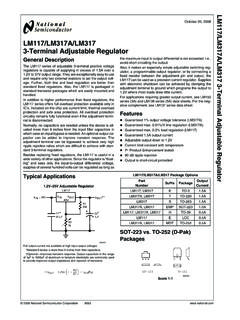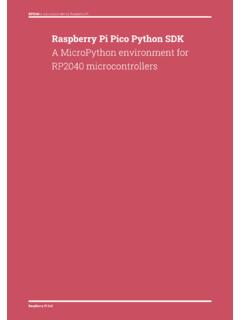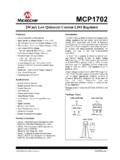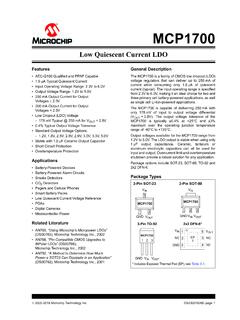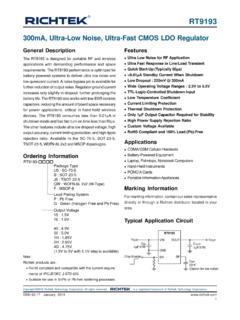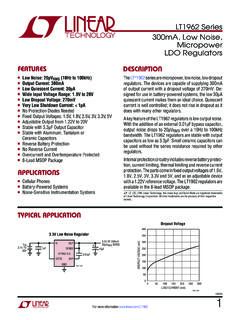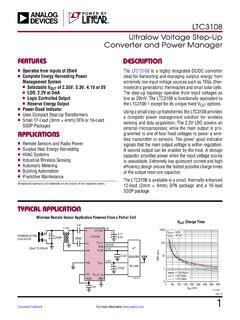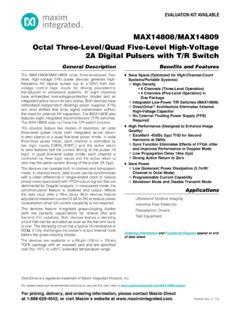Transcription of SPX3819 500mA, Low-Noise LDO Voltage Regulator
1 SPX3819 . 500ma , Low-Noise LDO Voltage Regulator FEATURES. Low noise : 40 V Possible High Accuracy: 1%. Reverse Battery Protection Low Dropout: 340mV at Full Load EN 1 8 ADJ/BYP. Low Quiescent current : 90 A SPX3819 GND. NC 2 7. Zero Off-Mode current Fixed Output: , , , , , VIN 3 8 Pin DFN 6 NC. , , 5 Pin SOT-23, 8 Pin nSOIC and 8 pin 2X3 DFN NC 4 5 VOUT. Packages. APPLICATIONS. Battery Powered Systems Now Available in Lead Free Packaging Cordless Phones Radio Control Systems Portable/Palm Top/Notebook Computers Portable Consumer Equipment Portable Instrumentation Bar Code Scanners SMPS Post regulators DESCRIPTION. The SPX3819 is a positive Voltage Regulator with a low dropout Voltage and low noise output. In addition, this device offers a very low ground current of 800 A at 100mA output. The SPX3819 has an initial tolerance of less than 1% max and a logic compatible ON/OFF switched input.
2 When disabled power consumption drop to nearly zero. Other key features include reverse battery protection, current limit, and thermal shutdown. The SPX3819 includes a reference bypass pin for optimal low noise output performance. With its very low output temperature coefficient, this device also makes a superior low power Voltage reference. The SPX3819 is an excellent choice for use in battery-powered applications such as cordless telephones, radio control systems, and portable computers. It is available in several fixed voltages , , , , , , , or with an adjustable output. This device is offered in 8 pin nSOIC, 8 pin DFN. and 5-pin SOT-23 packages. TYPICAL APPLICATION CIRCUIT. VIN 1 5 VOUT. +. 2. SPX3819 . + GND. 3 4. BYP. EN (Opt.). ENABLE may be tied directly to VIN. TOP View Date:6/8/2004 SPX3819 500ma , Low noise LDO Voltage Regulator Copyright 2004 Sipex Corporation 1.
3 ABSOLUTE MAXIMUM RATINGS. Power Dissipation .. Internally Limited Lead Temp. (Soldering, 5 Seconds) .. 260 C. Operating Junction Temperature Range .. -40 C to +125 C. Input Supply Voltage .. -20V to +20V. Enable Input Voltage .. -20V to +20V. RECOMMENDED OPERATIONG CONDITIONS. Input Voltage .. + to+16V. Operating Junction Temperature Range .. -40 C to +125 C. Enable Input Voltage .. 0V to VIN. ELECTRICAL CHARACTERISTICS. TJ=25 C, VOUT + 1V, for Option VIN=VOUT + IL=100 A, CL=1 F, and VENABLE The denotes the specifications which apply over full operating temperature range -40 C to +85 C, unless otherwise specified. PARAMETER MIN TYP MAX UNITS CONDITIONS. Output Voltage Tolerance -1 +1 %. -2 +2 . Output Voltage Temperature Coef. 57 ppm/ C. Line Regulation %/V VIN=VOUT + 1V to 16V. Load Regulation % IL = to 500ma .
4 Dropout Voltage 10 60 mV IL = 100 A. (VIN-VO)(Note 2) 80 . 125 175 mV IL = 50mA. 250 . 180 350 mV IL = 150mA. 450 . 340 550 mV IL = 500ma . 700 . Quiescent current (IGND) 3 A VENABLE 8 VENABLE Ground Pin current (IGND) 90 150 A IL = 100 A. 190 . 250 650 A IL = 50mA. 900 . mA IL = 150mA.. mA IL = 500ma .. Ripple Rejection (PSRR) 70 dB. current Limit (ILIMIT) 800 mA VOUT = 0V. 950 . Output noise (eNO) 300 VRMS IL=10mA, CL= F, CIN=1 F, (10Hz-100kHz). 40 VRMS IL=10mA, CL=10 F, CBYP =1 F, CIN =1 F, (10Hz-100kHz). Input Voltage Level Logic Low (VIL) V OFF. Input Voltage Level Logic High (VIH) 2 V ON. ENABLE Input current 2 A VIL 3 20 VIH Thermal Resistance (Note 1) 220 C/W SOT-23-5 / Junction to Ambient 180 C/W SO-8 / Junction to Ambient NOTES. Note 1: The maximum allowable power dissipation is a function of maximum operating junction temperature, TJ(max) the junction to ambient thermal resistance, and the ambient JA, and the ambient temperature TA.
5 The maximum allowable power dissipation at any ambient temperature is given: PD(max) = (TJ(max)-TA)/ JA, exceeding the maximum allowable power limit will result in excessive die temperature; thus, the Regulator will go into thermal shutdown. The JA of the SPX3819 is 220 C/W mounted on a PC board. Note 2: Not applicable to output Voltage 2V or less. Date:6/8/2004 SPX3819 500ma , Low noise LDO Voltage Regulator Copyright 2004 Sipex Corporation 2. TYPICAL PERFORMANCE CHARACTERISTICS. Device 160. VIN= CL = F 150. 140. 130. IGND (mA). 120. IGND ( A). 110. 100. 90 Device CL= F. 80 IL = 100 A. 70. 60. 0 100 200 300 400 500 4 6 8 10 12 14 16. IL (mA) VIN (V). Ground current vs Load current Ground current vs Input Voltage Device VIN= CL = F. IGND (mA). VOUT (V). Device CL= F. IL = 100 A. 4 6 8 10 12 14 16. 0 100 200 300 400 500.
6 IL (mA) VIN (V). Ground current vs Load current in Dropout Output Voltage vs Input Voltage Date:6/8/2004 SPX3819 500ma , Low noise LDO Voltage Regulator Copyright 2004 Sipex Corporation 3. TYPICAL PERFORMANCE CHARACTERISTICS: Continued 350 300 Device Device VIN= VIN= CL = F CL = F. 250. Dropout (mV). 200. VOUT (V). 150. 100. 50. 0. 0 100 200 300 400 500. 0 100 200 300 400 500. IL (mA) IL (mA). Dropout Voltage vs Load current Output Voltage vs Load current 130 360. Device VIN= F Device CL= F 340 VIN = 120 IL = 100 A CL= F. IL = 50mA. 320. 110. 300. IGND ( A). IGND ( A). 100 280. 260. 90. 240. 80. 220. 70 200. -40 -20 0 20 40 60 80 100 120 -40 -20 0 20 40 60 80 100 120. Temperature ( C) Temperature ( C). Ground current vs Temperature with 100 A Load Ground current vs Temperature with 50mA Load Date:6/8/2004 SPX3819 500ma , Low noise LDO Voltage Regulator Copyright 2004 Sipex Corporation 4.
7 TYPICAL PERFORMANCE CHARACTERISTICS: Continued Device VIN= F. Device CL= F. VIN= F IL = 500ma . CL= F. IL = 500ma . IGND (mA). IGND (mA). -40 -20 0 20 40 60 80 100 120 -40 -20 0 20 40 60 80 100 120. Temperature ( C) Temperature ( C). Ground current vs Temperature with 500ma Load Ground current vs Temperature in Dropout Device CL= F IL = 100 A Device VIN= F. CL= F. IL = 500ma . VEN, On Threshold (V). VOUT (V). 4 6 8 10 12 14 16 -40 -20 0 20 40 60 80 100 120. VIN (V) Temperature ( C). ENABLE Voltage , ON threshold, vs Input Voltage Output Voltage vs Temperature Date:6/8/2004 SPX3819 500ma , Low noise LDO Voltage Regulator Copyright 2004 Sipex Corporation 5. TYPICAL PERFORMANCE CHARACTERISTICS: Continued 350. Cin = 1uFT, Cout = 1uFT. 300 Cin = 1uFT, Cout = Cin = 1uFT. 250 Cout = 10uFT. 200. uV RMS. 150. 100. 50. 0.
8 1 10 100 1000 10000 100000 1000000. Bypass Cap (pF). Output noise vs Bypass Capacitor Value IL = 10mA, Line Transient Response for Device 10Hz - 100kHz Load Transient Response for Device Date:6/8/2004 SPX3819 500ma , Low noise LDO Voltage Regulator Copyright 2004 Sipex Corporation 6. APPLICATION INFORMATION. The SPX3819 requires an output capacitor for The SPX3819 start-up speed is inversely pro- device stability. Its value depends upon the portional to the size of the BYP capacitor. Ap- application circuit. In general, linear Regulator plications requiring a slow ramp-up of the out- stability decreases with higher output currents. put Voltage should use a larger CBYP. However, In applications where the SPX3819 is putting if a rapid turn-on is necessary, the BYP capaci- out less current , a lower output capacitance may tor can be omitted.
9 Be sufficient. For example, a Regulator sourcing only 10mA, requires approximately half the capacitance as the same Regulator sourcing The SPX3819 's internal reference is available 150mA. through the BYP pin. Bench testing is the best method for determining the proper type and value of the capacitor since Figure 1 represents a SPX3819 standard appli- the high frequency characteristics of electro- cation circuit. The EN (enable) pin is pulled lytic capacitors vary widely, depending on type high (> ) to enable the Regulator . and manufacturer. A high quality F alumi- To disable the Regulator , EN < num electrolytic capacitor works in most appli- cation circuits, but the same stability often can be obtained with a 1 F tantalum electrolytic. The SPX3819 in Figure 2 illustrates a typical adjustable output Voltage configuration.
10 Two resistors (R1 and R2) set the output Voltage . The With the SPX3819 adjustable version, the mini- output Voltage is calculated using the formula: mum value of output capacitance is a function of the output Voltage . The value decreases with higher output voltages, since closed loop gain is VOUT = x [ 1 + R1/R2]. increased. R2 must be > 10 k and for best results, R2. Typical Applications Circuits should be between 22 k and 47k . A capacitor A 10nF capacitor on BYP pin will significantly placed between Adj and ground will provide reduce output noise but it may be left uncon- improved noise performance. nected if the output noise is not a major concern. VIN 1 5 VOUT VIN 1 5 VOUT. + +. 2 2 R1. SPX3819 SPX3819 . + GND. + GND SOT-23. 3 4 ADJ. 3 4 EN. BYP. EN (Opt.). BYP R2. Hi-ON. (Opt.). ENABLE may be tied directly to VIN Lo-OFF.
